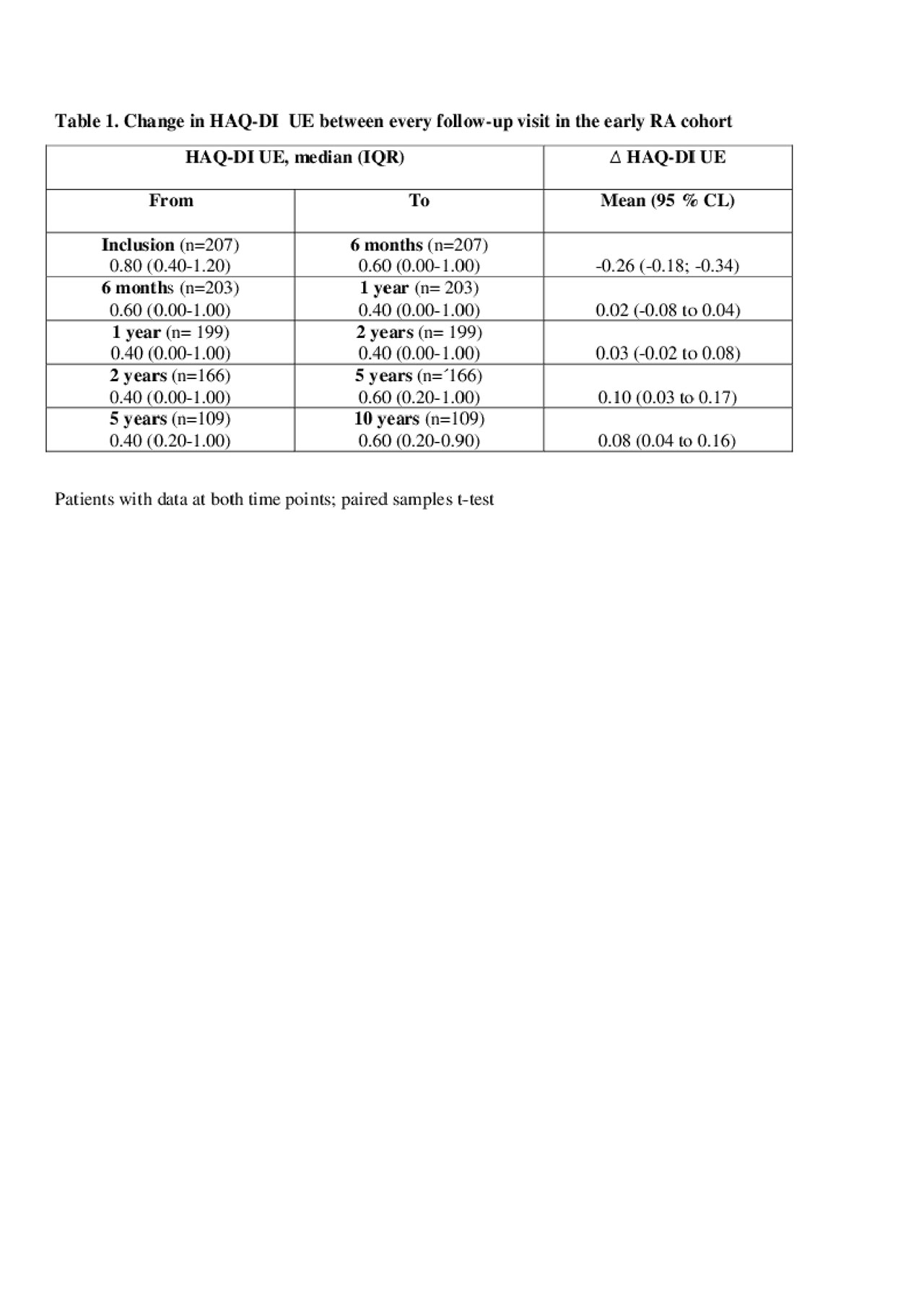Session Information
Date: Sunday, November 10, 2019
Title: RA – Diagnosis, Manifestations, & Outcomes Poster I: Risk Factors, Predictors, & Prognosis
Session Type: Poster Session (Sunday)
Session Time: 9:00AM-11:00AM
Background/Purpose: Patients with rheumatoid arthritis (RA) have increased disability, in particular due to involvement of the joints of the upper extremities. The Stanford Health Assessment Questionnaire (HAQ) includes questions related to both upper and lower extremity function. The objective of this study was to investigate the course of disability related to the upper extremities in early RA, using a subset of the HAQ disability index (HAQ-DI upper extremities; HAQ-DI UE), and to assess associations between HAQ-DI UE and disease parameters, including grip force.
Methods: An inception cohort of patients with early RA (symptom duration ≤12 months), recruited in 1995-2005, was investigated and followed in a structured program (5 examinations over 10 years), including clinical evaluation and grip force measurement. Disability was assessed using the validated Swedish version of the HAQ. In order to more specifically address disability of the upper extremities, we calculated the HAQ-DI UE, based on the 10 questions that cover activities that are mainly dependent on function of the upper extremities. Grip force was measured using the electronic instrument Grippit (AB Detektor, Gothenburg, Sweden). Average grip force values of the dominant hand were evaluated at each visit, and compared to the expected, based on age- and sex-specific reference values from the literature. Grip force was expressed as % of predicted values. Changes in HAQ-DI UE between two consecutive follow-up visits over time, baseline to 10 years follow-up, in the early RA cohort with data on both time points, were estimated using the paired samples t-test. Spearman’s test was used to further explore correlations between HAQ-DI UE and grip force, swollen and tender joint counts (SJC and TJC), visual analogue scales for patient global assessment (VAS global) and pain (VAS pain), ESR and CRP at each visit.
Results: A total of 222 patients with early RA (71 % women, mean age 61 years, median symptom duration 7 months) were investigated. At inclusion, the mean DAS28 was 4.6 (SD 1.4), and the median HAQ-DI was 0.75 (IQR 0.38-1.25). Data on both HAQ-DI UE and average grip force of the dominant hand were available for 222 patients at inclusion, 207 patients at 6 month, 209 at 1 year, 200 at 2 years, 167 at 5 years and 110 at 10 years. In the paired analysis of patients with available data at both time points there was a significant decrease in HAQ-DI UE from inclusion to 6 months follow-up (Table 1). HAQ-DI UE levels were stable between 6 month and 2 years, whereas between 2 years and 5 years, there was a significant increase. (Table 1) The mean average grip force of the dominant hand increased from 40 % of expected at inclusion to 66 % of expected at 10 years. There were strong correlations for HAQ-DI UE with grip force, VAS global and VAS pain at all time points, and moderate to weak correlations with SJC, TJC, ESR and CRP (Table 2).
Conclusion: In this study of patients with early RA, disability related to the upper extremities decreased from inclusion to the 6 month follow-up, and increased again after 2 years. HAQ-DI UE scores correlated strongly with grip force and patient reported outcomes, and to a lesser extent with joint counts and laboratory markers of inflammation.
To cite this abstract in AMA style:
Rydholm M, Wikström I, Mellblom Bengtsson M, Hagel S, Jacobsson L, Turesson C. The Course of Disability Related to Function of the Upper Extremities in Early Rheumatoid Arthritis over 10 Years of Follow-up [abstract]. Arthritis Rheumatol. 2019; 71 (suppl 10). https://acrabstracts.org/abstract/the-course-of-disability-related-to-function-of-the-upper-extremities-in-early-rheumatoid-arthritis-over-10-years-of-follow-up/. Accessed .« Back to 2019 ACR/ARP Annual Meeting
ACR Meeting Abstracts - https://acrabstracts.org/abstract/the-course-of-disability-related-to-function-of-the-upper-extremities-in-early-rheumatoid-arthritis-over-10-years-of-follow-up/


